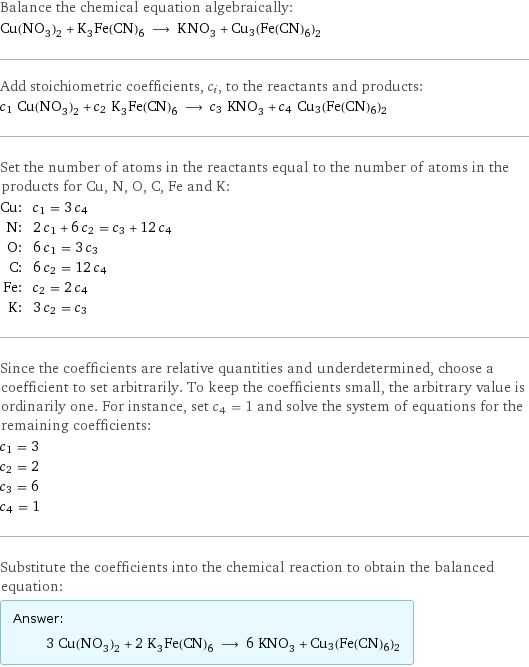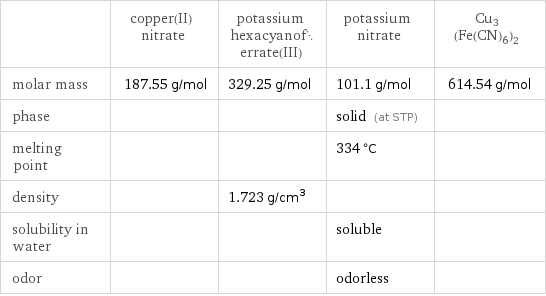Input interpretation

Cu(NO_3)_2 (copper(II) nitrate) + K_3Fe(CN)_6 (potassium hexacyanoferrate(III)) ⟶ KNO_3 (potassium nitrate) + Cu3(Fe(CN)6)2
Balanced equation

Balance the chemical equation algebraically: Cu(NO_3)_2 + K_3Fe(CN)_6 ⟶ KNO_3 + Cu3(Fe(CN)6)2 Add stoichiometric coefficients, c_i, to the reactants and products: c_1 Cu(NO_3)_2 + c_2 K_3Fe(CN)_6 ⟶ c_3 KNO_3 + c_4 Cu3(Fe(CN)6)2 Set the number of atoms in the reactants equal to the number of atoms in the products for Cu, N, O, C, Fe and K: Cu: | c_1 = 3 c_4 N: | 2 c_1 + 6 c_2 = c_3 + 12 c_4 O: | 6 c_1 = 3 c_3 C: | 6 c_2 = 12 c_4 Fe: | c_2 = 2 c_4 K: | 3 c_2 = c_3 Since the coefficients are relative quantities and underdetermined, choose a coefficient to set arbitrarily. To keep the coefficients small, the arbitrary value is ordinarily one. For instance, set c_4 = 1 and solve the system of equations for the remaining coefficients: c_1 = 3 c_2 = 2 c_3 = 6 c_4 = 1 Substitute the coefficients into the chemical reaction to obtain the balanced equation: Answer: | | 3 Cu(NO_3)_2 + 2 K_3Fe(CN)_6 ⟶ 6 KNO_3 + Cu3(Fe(CN)6)2
Structures

+ ⟶ + Cu3(Fe(CN)6)2
Names

copper(II) nitrate + potassium hexacyanoferrate(III) ⟶ potassium nitrate + Cu3(Fe(CN)6)2
Equilibrium constant
![Construct the equilibrium constant, K, expression for: Cu(NO_3)_2 + K_3Fe(CN)_6 ⟶ KNO_3 + Cu3(Fe(CN)6)2 Plan: • Balance the chemical equation. • Determine the stoichiometric numbers. • Assemble the activity expression for each chemical species. • Use the activity expressions to build the equilibrium constant expression. Write the balanced chemical equation: 3 Cu(NO_3)_2 + 2 K_3Fe(CN)_6 ⟶ 6 KNO_3 + Cu3(Fe(CN)6)2 Assign stoichiometric numbers, ν_i, using the stoichiometric coefficients, c_i, from the balanced chemical equation in the following manner: ν_i = -c_i for reactants and ν_i = c_i for products: chemical species | c_i | ν_i Cu(NO_3)_2 | 3 | -3 K_3Fe(CN)_6 | 2 | -2 KNO_3 | 6 | 6 Cu3(Fe(CN)6)2 | 1 | 1 Assemble the activity expressions accounting for the state of matter and ν_i: chemical species | c_i | ν_i | activity expression Cu(NO_3)_2 | 3 | -3 | ([Cu(NO3)2])^(-3) K_3Fe(CN)_6 | 2 | -2 | ([K3Fe(CN)6])^(-2) KNO_3 | 6 | 6 | ([KNO3])^6 Cu3(Fe(CN)6)2 | 1 | 1 | [Cu3(Fe(CN)6)2] The equilibrium constant symbol in the concentration basis is: K_c Mulitply the activity expressions to arrive at the K_c expression: Answer: | | K_c = ([Cu(NO3)2])^(-3) ([K3Fe(CN)6])^(-2) ([KNO3])^6 [Cu3(Fe(CN)6)2] = (([KNO3])^6 [Cu3(Fe(CN)6)2])/(([Cu(NO3)2])^3 ([K3Fe(CN)6])^2)](../image_source/afee045eaaf0f3bfc62914f892dc4a30.png)
Construct the equilibrium constant, K, expression for: Cu(NO_3)_2 + K_3Fe(CN)_6 ⟶ KNO_3 + Cu3(Fe(CN)6)2 Plan: • Balance the chemical equation. • Determine the stoichiometric numbers. • Assemble the activity expression for each chemical species. • Use the activity expressions to build the equilibrium constant expression. Write the balanced chemical equation: 3 Cu(NO_3)_2 + 2 K_3Fe(CN)_6 ⟶ 6 KNO_3 + Cu3(Fe(CN)6)2 Assign stoichiometric numbers, ν_i, using the stoichiometric coefficients, c_i, from the balanced chemical equation in the following manner: ν_i = -c_i for reactants and ν_i = c_i for products: chemical species | c_i | ν_i Cu(NO_3)_2 | 3 | -3 K_3Fe(CN)_6 | 2 | -2 KNO_3 | 6 | 6 Cu3(Fe(CN)6)2 | 1 | 1 Assemble the activity expressions accounting for the state of matter and ν_i: chemical species | c_i | ν_i | activity expression Cu(NO_3)_2 | 3 | -3 | ([Cu(NO3)2])^(-3) K_3Fe(CN)_6 | 2 | -2 | ([K3Fe(CN)6])^(-2) KNO_3 | 6 | 6 | ([KNO3])^6 Cu3(Fe(CN)6)2 | 1 | 1 | [Cu3(Fe(CN)6)2] The equilibrium constant symbol in the concentration basis is: K_c Mulitply the activity expressions to arrive at the K_c expression: Answer: | | K_c = ([Cu(NO3)2])^(-3) ([K3Fe(CN)6])^(-2) ([KNO3])^6 [Cu3(Fe(CN)6)2] = (([KNO3])^6 [Cu3(Fe(CN)6)2])/(([Cu(NO3)2])^3 ([K3Fe(CN)6])^2)
Rate of reaction
![Construct the rate of reaction expression for: Cu(NO_3)_2 + K_3Fe(CN)_6 ⟶ KNO_3 + Cu3(Fe(CN)6)2 Plan: • Balance the chemical equation. • Determine the stoichiometric numbers. • Assemble the rate term for each chemical species. • Write the rate of reaction expression. Write the balanced chemical equation: 3 Cu(NO_3)_2 + 2 K_3Fe(CN)_6 ⟶ 6 KNO_3 + Cu3(Fe(CN)6)2 Assign stoichiometric numbers, ν_i, using the stoichiometric coefficients, c_i, from the balanced chemical equation in the following manner: ν_i = -c_i for reactants and ν_i = c_i for products: chemical species | c_i | ν_i Cu(NO_3)_2 | 3 | -3 K_3Fe(CN)_6 | 2 | -2 KNO_3 | 6 | 6 Cu3(Fe(CN)6)2 | 1 | 1 The rate term for each chemical species, B_i, is 1/ν_i(Δ[B_i])/(Δt) where [B_i] is the amount concentration and t is time: chemical species | c_i | ν_i | rate term Cu(NO_3)_2 | 3 | -3 | -1/3 (Δ[Cu(NO3)2])/(Δt) K_3Fe(CN)_6 | 2 | -2 | -1/2 (Δ[K3Fe(CN)6])/(Δt) KNO_3 | 6 | 6 | 1/6 (Δ[KNO3])/(Δt) Cu3(Fe(CN)6)2 | 1 | 1 | (Δ[Cu3(Fe(CN)6)2])/(Δt) (for infinitesimal rate of change, replace Δ with d) Set the rate terms equal to each other to arrive at the rate expression: Answer: | | rate = -1/3 (Δ[Cu(NO3)2])/(Δt) = -1/2 (Δ[K3Fe(CN)6])/(Δt) = 1/6 (Δ[KNO3])/(Δt) = (Δ[Cu3(Fe(CN)6)2])/(Δt) (assuming constant volume and no accumulation of intermediates or side products)](../image_source/cb8a91a51b93803c7d288bd92ecede10.png)
Construct the rate of reaction expression for: Cu(NO_3)_2 + K_3Fe(CN)_6 ⟶ KNO_3 + Cu3(Fe(CN)6)2 Plan: • Balance the chemical equation. • Determine the stoichiometric numbers. • Assemble the rate term for each chemical species. • Write the rate of reaction expression. Write the balanced chemical equation: 3 Cu(NO_3)_2 + 2 K_3Fe(CN)_6 ⟶ 6 KNO_3 + Cu3(Fe(CN)6)2 Assign stoichiometric numbers, ν_i, using the stoichiometric coefficients, c_i, from the balanced chemical equation in the following manner: ν_i = -c_i for reactants and ν_i = c_i for products: chemical species | c_i | ν_i Cu(NO_3)_2 | 3 | -3 K_3Fe(CN)_6 | 2 | -2 KNO_3 | 6 | 6 Cu3(Fe(CN)6)2 | 1 | 1 The rate term for each chemical species, B_i, is 1/ν_i(Δ[B_i])/(Δt) where [B_i] is the amount concentration and t is time: chemical species | c_i | ν_i | rate term Cu(NO_3)_2 | 3 | -3 | -1/3 (Δ[Cu(NO3)2])/(Δt) K_3Fe(CN)_6 | 2 | -2 | -1/2 (Δ[K3Fe(CN)6])/(Δt) KNO_3 | 6 | 6 | 1/6 (Δ[KNO3])/(Δt) Cu3(Fe(CN)6)2 | 1 | 1 | (Δ[Cu3(Fe(CN)6)2])/(Δt) (for infinitesimal rate of change, replace Δ with d) Set the rate terms equal to each other to arrive at the rate expression: Answer: | | rate = -1/3 (Δ[Cu(NO3)2])/(Δt) = -1/2 (Δ[K3Fe(CN)6])/(Δt) = 1/6 (Δ[KNO3])/(Δt) = (Δ[Cu3(Fe(CN)6)2])/(Δt) (assuming constant volume and no accumulation of intermediates or side products)
Chemical names and formulas

| copper(II) nitrate | potassium hexacyanoferrate(III) | potassium nitrate | Cu3(Fe(CN)6)2 formula | Cu(NO_3)_2 | K_3Fe(CN)_6 | KNO_3 | Cu3(Fe(CN)6)2 Hill formula | CuN_2O_6 | C_6FeK_3N_6 | KNO_3 | C12Cu3Fe2N12 name | copper(II) nitrate | potassium hexacyanoferrate(III) | potassium nitrate | IUPAC name | copper(II) nitrate | ferric tripotassium hexacyanide | potassium nitrate |
Substance properties

| copper(II) nitrate | potassium hexacyanoferrate(III) | potassium nitrate | Cu3(Fe(CN)6)2 molar mass | 187.55 g/mol | 329.25 g/mol | 101.1 g/mol | 614.54 g/mol phase | | | solid (at STP) | melting point | | | 334 °C | density | | 1.723 g/cm^3 | | solubility in water | | | soluble | odor | | | odorless |
Units
